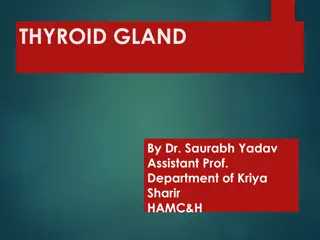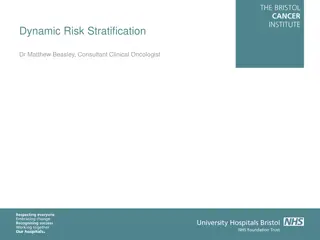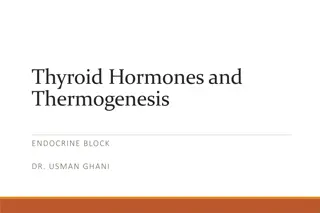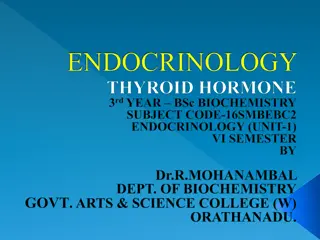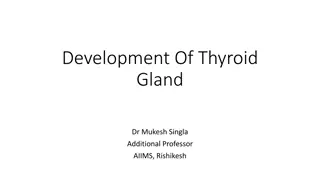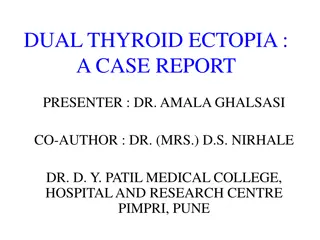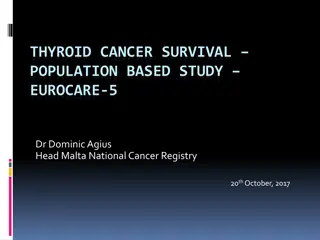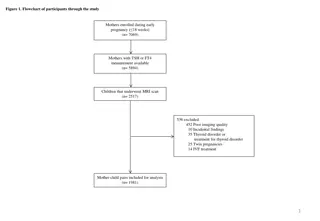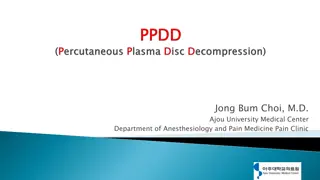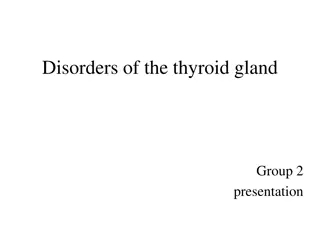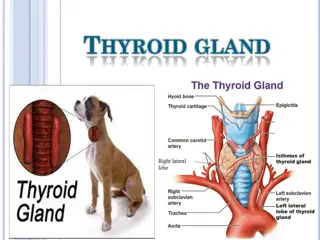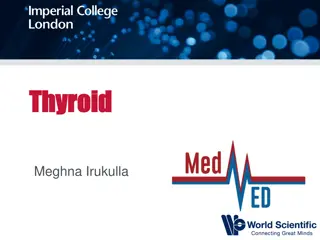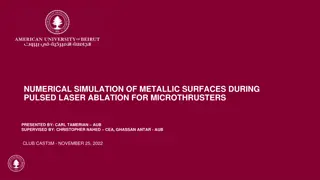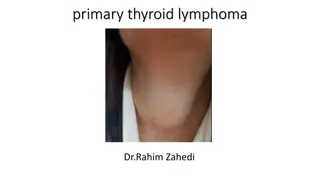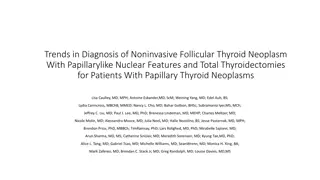
Thermal Ablation for Papillary Thyroid Microcarcinomas - Key Insights
Learn about the increasing incidence of papillary thyroid carcinomas (PTCs) and the use of thermal ablation for managing Papillary Thyroid Microcarcinomas (PTMCs) through active surveillance. Understand the indolent nature of PTMCs, the American Thyroid Association guidelines, and the benefits of active surveillance over immediate surgery. Discover the latest research findings on active surveillance for low-risk PTMC patients, including acceptable outcomes in terms of size enlargement and lymph node metastasis over a 5-year follow-up period.
Download Presentation

Please find below an Image/Link to download the presentation.
The content on the website is provided AS IS for your information and personal use only. It may not be sold, licensed, or shared on other websites without obtaining consent from the author. If you encounter any issues during the download, it is possible that the publisher has removed the file from their server.
You are allowed to download the files provided on this website for personal or commercial use, subject to the condition that they are used lawfully. All files are the property of their respective owners.
The content on the website is provided AS IS for your information and personal use only. It may not be sold, licensed, or shared on other websites without obtaining consent from the author.
E N D
Presentation Transcript
Thermal Ablation for Papillary Thyroid Microcarcinomas PTMCs Bijan Iraj,MD Assistant Professor of Internal Medicine and Endocrinology Department of Endocrinology and Metabolism Isfahan Medical School
The incidence of papillary thyroid carcinoma (PTC) and the number of these patients requiring subsequent surgery have markedly increased over the past 20 years. These increases are due primarily to the incidental detection of small, subclinical PTCs and/or early ultrasound screening.
PTMC usually does not become clinically evident and is associated with an excellent prognosis, either because the rate of progression is very slow or because the tumor does not progress.
The American Thyroid Association guidelines suggested that an active surveillance can be considered in PTMC patients without local invasion or clinically evident metastases, and in patients who have high surgical risk, short remaining life span or concurrent medical issues requiring priority treatment.
The indolent characteristics of PTC have reduced the need for immediate surgery, as surgery has several important drawbacks, including vocal cord paralysis, hypoparathyroidism, and post surgical complications.
Active surveillance (AS) is considered the alternative first line option for patients with low risk papillary thyroid microcarcinoma (PTMC), as it reduces overtreatment and unnecessary surgery, while showing favorable results, in these patients.
According to a recent systematic review and meta analysis, AS shows acceptable size enlargement and lymph node metastasis during 5 year follow up (pooled proportion of 5.3% and 1.6%, respectively). Sakai T, Sugitani I, Ebina A, Fukuoka O, Toda K, Mitani H, Yamada K 2019 Active Surveillance for T1bN0M0 Papillary Thyroid Carcinoma. Thyroid : official journal of the American Thyroid Association 29:59 63.
Active surveillance can be an important management alternative for these patients. however, considering that over 10% of patients stopped active surveillance and underwent surgery without progression of disease in observational trials for PTMC.
However, a large proportion (ranged 8.7 to 32 %) of patients underwent delayed surgery. Among them, a substantial proportion (ranging from 50 to 69%) of the reasons for delayed surgery were distinct from size enlargement or lymph node metastasis. Cho SJ, Suh CH, Baek JH, Chung SR, Choi YJ, Chung KW, Shong Y, Lee JH 2019 Active Surveillance for Small Papillary Thyroid Cancer: A Systematic Review and Meta Analysis. Thyroid : official journal of the American Thyroid Association.
Moreover, the tumor could evoke considerable patient anxiety when it is left untreated.
Active surveillance does not seem to be a perfect strategy for all patients.
In recent years, image-guided ablations including ethanol injection, radiofrequency ablation (RFA) and microwave ablation (MWA) have attracted much interest in the minimally invasive treatment of various tumors such as neoplasm's of the liver, kidney and lung.
These techniques have been regarded as an alternative to surgery. Several studies showed that RFA and MWA have been used to treat thyroid nodules and metastatic lymph nodes from PTC, yielding favorable results.
US-guided laser ablation (LA) has also been demonstrated to be an effective method to reduce the volume of benign thyroid nodules , and to treat malignant diseases such as early hepatocellular carcinoma and metastatic lymph nodes from PTC.
However, several recent studies have suggested the application of RFA for low-risk PMC Kim et al. reported their indications as follows: Pathologically confirmed PTC without cytological aggressiveness, Single PTC without extrathyroidal extension, No metastatic tumours Ineligibility for surgery
Zhang M, Luo Y, Zhang Y, et al. (2016). Efficacy and safety of ultrasound-guided radiofrequency ablation for treating low-risk papillary thyroid microcarcinoma: a prospective study. Thyroid 26:1581 7. Sun J, Liu X, Zhang Q, et al. (2016). Papillary thyroid carcinoma treated with radiofrequency ablation in a patient with hypertrophic cardiomyopathy: a case report. Korean J Radiol 17:558 61. Kim JH, Baek JH, Sung JY, et al. (2017). Radiofrequency ablation of low-risk small papillary thyroidcarcinoma: preliminary results for patients ineligible for surgery. Int J Hyperthermia 33:212 19.
Techniques: Before starting ablation, the target tumor is divided into multiple conceptual ablation units, and RFA is performed in a unit-by-unit manner by moving the electrode tip. The use of local anaesthesia rather than general anaesthesia or sedation. If a metastatic tumour exists adjacent to these nerves, the hydrodissection technique is useful to prevent thermal injury.
Danger triangle, i.e. the tracheoesophageal groove including the RLN, trachea, and esophagus.
Ablation should be terminated when all conceptual units have changed to transient hyper echoic zones. RFA is usually performed on both the tumor and the surrounding normal tissue in order to prevent local recurrence.
If patients cannot tolerate the pain during ablation, lidocaine injection around the tumour is recommended.
Based on the clinical framework for risk stratification in determining whether AS is appropriate for PTMC categorized patients as ideal, appropriate, or inappropriate for AS based on imaging findings, and the characteristics of the patient and/or medical team.
low-risk has been described as the absence of clinically evident metastases, local invasion and aggressive cytological evidence.
Based on strict stratification, the patients classified as inappropriate for AS should not be considered for thermal ablation. However, patients with a fear of undergoing surgery can be considered for thermal ablation.
However, patients with a fear of undergoing surgery can be considered for thermal ablation.
Treatment efficacy: Volume reduction , therapeutic success rate (volume reduction >50%) , complete disappearance of the treated cancer, serum thyroglobulin concentration, cancer perfusion, and changes in echogenicity. Ethanol and thermal ablation for malignant So Yeong Jeong, Jung Hwan Baek, Young Jun Choi & Jeong Hyun Lee International Journal of Hyperthermia 2017
The efficacy of RFA: The mean reduction in tumour volume ranged from 50.9% to 84%; complete disappearance is noted in 25 94% of cancers ; therapeutic success rates range from 75% to 97% ; symptom improvement is observed in 64% of patients ; and decreases in serum thyroglobulin concentration are noted in most patients.
The efficacy of EA: The reduction in the mean cancer volume following EA reportedly ranges from 37.5% to 96%; complete disappearance is noted in31 65% of treated cancers ; therapeutic success rates range from 70.8% to 98% ; and reductions in serum thyroglobulin concentration are noted in some patients.
RFA is superior to EA because of its better efficacy, fewer mean number of treatment sessions required, and wider extent of the ablation zone. However, RFA demonstrates a higher tendency and severity of voice complications than EA in the treatment of central neck lesions.
Thermal Ablation for Papillary Thyroid Microcarcinomas: Systematic Review and Meta Analysis: THYROID-2019
503 lowrisk PTMCs in 470 patients treated by thermal ablation from 9 studies.
Inclusion Criteria: 1- Greatest tumor dimension 10 mm; 2- Diagnosis by cytology or biopsy, 3-Absence of lymph node (LN) metastasis, distant metastasis, and gross extra thyroidal extension 4-Included evaluation of efficacy after thermal ablation. Thermal ablation included MWA, LA, and RFA.
Results of Ablation: The mean FU duration after ablation ranged from 7.8 months to over 53 months. The mean size of the index tumor before and immediately after ablation and at last FU ranged from 4.3 to 7.5 mm (41 to 157 mm3), 11.8 to 14.1 mm (517.6 to 3099.4 mm3), and 0 to 4mm (0 to 70 mm3), respectively.
Disappearance rate was defined as complete tumor disappearance or the presence of residual scar like changes.
None of these patients experienced local tumor recurrence or distant metastasis. However, two patients developed LN metastasis during FU. In addition, one patient developed a new cancer, which completely disappeared following additional ablation.
During followup, no patient experienced local tumor recurrence or distant metastasis, whereas two patients (0.4%) experienced lymph node metastasis. One patient (0.2%) developed a new PTMC, which was successfully treated by additional ablation. Five patients (1.1%) underwent delayed surgery after ablation, including the two patients with lymph node metastasis and three additional patients with unknown etiology.
The finding, that most of the complications were minor, with transient hoarseness being the most frequent complication, indicates that the operator should be thoroughly trained in US based anatomy, especially in the evaluation of the danger triangle.
The rate of minor complications per tumor in the other four studies were 3.4%, 4.3%, 5.4%, and 19%, respectively, with the most common complication being transient hoarseness.
Li J, Liu Y, Liu J, Qian L 2018 Ultrasoundguided percutaneous microwave ablation versus surgery for papillary thyroid microcarcinoma. International journal of hyperthermia : the official journal of European Society for Hyperthermic Oncology, North American Hyperthermia Group 34:653 659. Teng D, Sui G, Liu C, Wang Y, Xia Y, Wang H 2018 Long term efficacy of ultrasoundguided low power microwave ablation for the treatment of primary papillary thyroid microcarcinoma: a 3 year follow up study. Journal of cancer research and clinical oncology 144:771 779. Teng DK, Li HQ, Sui GQ, Lin YQ, Luo Q, Fu P, Du JR, Jin CX, Wang H 2019 Preliminary report of microwave ablation for the primary papillary thyroid microcarcinoma: a large cohort of 185 patients feasibility study. Endocrine 64:109 117. Yue W, Wang S, Yu S, Wang B 2014 Ultrasound guided percutaneous microwave ablation of solitary T1N0M0 papillary thyroid microcarcinoma: initial experience. International journal of hyperthermia : the official journal of European Society for Hyperthermic Oncology, North American Hyperthermia Group 30:150 157. Zhang L, Zhou W, Zhan W, Peng Y, Jiang S, Xu S 2018 Percutaneous Laser Ablation of Unifocal Papillary Thyroid Microcarcinoma: Utility of Conventional Ultrasound and Contrast Enhanced Ultrasound in Assessing Local Therapeutic Response. World journal of surgery 42:2476 2484.
Fatal complications, such as injury to the oesophagus, trachea, or other nerves (i.e. phrenic nerve and brachial plexus), following the treatment of primary or recurrent thyroid cancers, which are often located adjacent to these structures, have not been reported.
Moreover only 1.1% of patients in the present study underwent delayed surgery after thermal ablation, with none undergoing delayed surgery because of the patient s anxiety about tumor progression. By treating the primary tumor, thermal ablation may alleviate or eliminate patient anxiety.
Multifocality was reported to be unilateral or bilateral in 20 40% of patients with PTMC , however, it could not be absolutely excluded without surgical excision.

